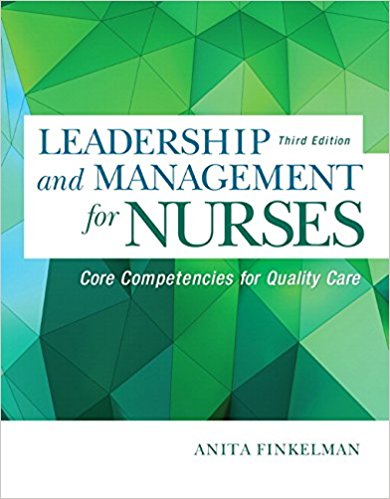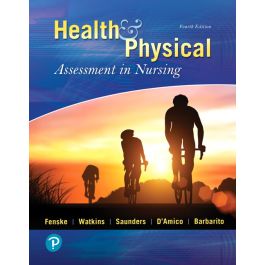In Stock
Test Bank For Health And Physical Assessment In Nursing 4th Edition Fenske
Edition: 4th Edition
Format: Downloadable ZIP Fille
Resource Type: Test bank
Duration: Unlimited downloads
Delivery: Instant Download
$25.00
Test Bank For Health And Physical Assessment In Nursing 4th Edition Fenske
Chapter 1 Health Assessment
1) A client with a self-reported history of type 2 diabetes mellitus and an ulcer wound on the
left foot states to the nurse, “I am healthy, I don’t know why I have to be here to get a
check-up.” Which statement by the nurse is the most appropriate?
1. “I feel that you are in denial about your health status.”
2. “Tell me about your definition of being healthy.”
3. “Do you understand what diabetes is?”
4. “Is there anything else you are not telling me?”
Answer: 2
Explanation: 1. More information would be needed before the nurse could attribute the
client’s viewpoint as denial or lack of knowledge.
2. During the process of gathering the subjective data from the client, the nurse must be
attuned to what the patient says, along with the signs, symptoms, behaviors, and cues offered
by the patient. This situational awareness and focused data collection will enable the nurse to
create a comprehensive database about the patient.
3. The client’s history of type 2 diabetes requires further investigation but the nurse must first
ascertain the client’s definition of what healthy means.
4. There is not enough information to determine the client’s withholding of information to the
nurse.
Page Ref: 4
Cognitive Level: Analyzing
Client Need & Sub: Physiological Adaptation; Illness Management
Standards: QSEN Competencies: I.B.1. Elicit patient values, preferences, and expressed needs
as part of clinical interview, implementation of care plan, and evaluation of care. | AACN
Essentials Competencies: IX.1. Conduct comprehensive and focused physical, behavioral,
psychological, spiritual, socioeconomic, and environmental assessments of health and illness
parameters in patients, using developmentally and culturally appropriate approaches. | NLN
Competencies: Context and Environment: Environmental health; health promotion/disease
prevention (e.g., transmission of disease, disease patterns, epidemiological principles); chronic
disease management; healthcare systems; transcultural approaches to health; and family
dynamics. | Nursing/Integrated Concepts: Nursing Process: Assessment
Learning Outcome: 1.5: Apply the critical thinking process to health assessment in nursing.
MNL Learning Outcome: 1.2: Recognize the significance of evidence-based practice and its use
in nursing.
2) The nurse is preparing to provide teaching to a client at risk for diabetes. During which time
should the nurse recognize is the most effective moment for teaching?
1. During health promotion.
2. When the client is ready to learn.
3. During the discussion of disease prevention.
4. When a knowledge deficit has been identified.
Answer: 2
Explanation: 1. Health promotion is important; however, if the client is not ready to learn new
information, the teaching may be ineffective.
2. A client must be ready to learn new information or the teaching may be ineffective.
3. Disease prevention is important; however, if the client is not ready to learn new information,
the teaching may be ineffective.
4. Once the knowledge deficit is identified, it is important that client is ready to learn or the
teaching may be ineffective.
Page Ref: 2
Cognitive Level: Applying
Client Need & Sub: Health Promotion and Maintenance; Health Promotion/Disease Prevention
Standards: QSEN Competencies: III.B.3. Base individualized care plan on patient values, clinical
expertise, and evidence. | AACN Essentials Competencies: IX.7. Provide appropriate patient
teaching that reflects developmental stage, age, culture, spirituality, patient preferences, and
health literacy considerations to foster patient engagement in their care. | NLN Competencies:
Learning Outcome: 1.3: Explain the steps of the nursing process.
MNL Learning Outcome: 1.1: Distinguish between the various roles of the professional nurse in
healthcare.
3) The nurse is conducting a workshop on wellness and health promotion using the initiatives
of Healthy People 2020. After the session, which statement by a participant indicates an
understanding of the initiatives?
1. “It will allow healthcare providers to lobby legislators for more funding.”
2. “The primary goal of Healthy People 2020 is to assist healthcare providers in determining risk
factors for premature birth.”
3. “Healthy People 2020 seeks to promote health, prevent illness, disability, and premature
death.”
4. “The initiatives will outline standards of care for providers in managing diseases.”
Answer: 3
Explanation: 1. Healthcare providers and other persons interested in programs to promote
health have found the document to be a useful source of information in their efforts to gain
funding.
2. The Healthy People 2020 initiative is a 10-year strategy intended to promote health, prevent
illness, disability, and premature death. The document identifies leading health indicators that
reflect public health concerns. Risk factors for premature birth may be part of those health
indicators, but the scope of the document covers broad areas of concern.
3. The Healthy People 2020 initiative is a 10-year strategy intended to promote health, prevent
illness, disability, and premature death.
4. Standards of care in disease management is not a component of the document.
Page Ref: 7
Client Need & Sub: Health Promotion and Maintenance; Health Promotion/Disease Prevention
Standards: QSEN Competencies: I.A.1. Integrate understanding of multiple dimensions of
patient centered care; patient/family/community preferences and values; coordination and
integration of care; information, communication, and education; physical comfort and
emotional support; involvement of family and friends; and transition and continuity. | AACN
Essentials Competencies: IX.2. Recognize the relationship of genetics and genomics to health,
prevention, screening, diagnostics, prognostics, selection of treatment, and monitoring of
treatment effectiveness, using a constructed pedigree from collected family history information
as well as standardized symbols and terminology. | NLN Competencies: Teamwork: Adapt
communication to the team and situation to share information or solicit input and initiate
requests for help when appropriate. | Nursing/Integrated Concepts: Nursing Process:
Assessment
Learning Outcome: 1.6: Describe the concepts of health, wellness, and health disparities.
MNL Learning Outcome: 1.2: Recognize the significance of evidence-based practice and its use
in nursing.
4) The nurse is reviewing the advanced practice roles in nursing. Which role should the nurse
recognize is most likely to provide indirect patient care?
1. Nurse Researcher.
2. Nurse Administrator.
3. Nurse Educator.
4. Nurse Anesthetist.
Answer: 2
Explanation: 1. A nurse researcher may provide direct care through their work in a clinic,
hospital, or laboratory focusing on patient care outcomes, administering treatments for clinical
trial, or collecting data to help understand population based outcomes.
2. The nurse administrator does not provide direct patient care but may be utilized for
consultation. Other responsibilities vary and could include management of complex patient
care areas, staffing, budgets, organizational and staff performance, and ensuring that the goals
of the agency are being accomplished.
3. The nurse educator is responsible for didactic and clinical teaching, curriculum development,
clinical placement, and evaluation of learning. Direct patient care occurs during clinical
teaching.
4. The nurse anesthetist has direct patient care by providing a full range of anesthesia services.
Page Ref: 2
Cognitive Level: Applying
Client Need & Sub: Management of Care; Concepts of Management
Standards: QSEN Competencies: II.B.4. Function competently within own scope of practice as a
member of the healthcare team. | AACN Essentials Competencies: VI.1. Compare/contrast the
roles and perspectives of the nursing profession with other care professionals on the healthcare
team (i.e. scope of discipline, education, and licensure requirements). | NLN Competencies:
Teamwork: Clarify roles and integrate the contributions of others who play a role in helping the
patient/family achieve health goals; function competently within one’s own scope of practice as
leader or member of the healthcare team; and manage delegation effectively. |
Nursing/Integrated Concepts: Nursing Process: Assessment
Learning Outcome: 1.1: Explain the roles of the professional nurse in healthcare.
MNL Learning Outcome: 1.1: Distinguish between the various roles of the professional nurse in
healthcare.
5) The nurse conducts a health history while admitting a client to the acute care facility. When
collecting primary subjective data, which source should the nurse use?
1. The client’s physical assessment.
2. The client’s self-reports.
3. The client’s healthcare provider.
4. The client’s significant other.
Answer: 2
Explanation: 1. The physical assessment will be recorded as objective data.
2. Subjective data are gathered from the interview. The interview includes the health history
and focused interview of the patient which is considered primary subjective data.
3. The client’s healthcare provider and significant other may contribute in the data collection
process. The information obtained from friends and family members is considered subjective.
This source of information is termed secondary.
4. The client’s significant other may contribute in the data collection process but that input is
classified as secondary data.
Page Ref: 6
Cognitive Level: Applying
Client Need & Sub: Health Promotion and Maintenance; Health Promotion/Disease Prevention
Standards: QSEN Competencies: I.B.1. Elicit patient values, preferences and expressed needs as
part of clinical interview, implementation of care plan, and evaluation of care. | AACN
Essentials Competencies: IX.1. Conduct comprehensive and focused physical, behavioral,
psychological, spiritual, socioeconomic, and environmental assessments of health and illness
parameters in patients, using developmentally and culturally appropriate approaches. | NLN
Competencies: Relationship-Centered Care: Communicate effectively with all members of the
healthcare team, including the patient and the patient’s support network. | Nursing/Integrated
Concepts: Nursing Process: Assessment
Learning Outcome: 1.2: Explain evidence-based practice and its significance in nursing.
MNL Learning Outcome: 1.3: Examine the steps of the nursing process and their association
with critical thinking.



